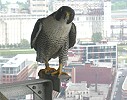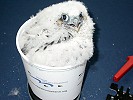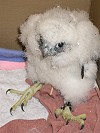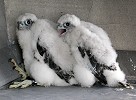|
|
|
Notes
from the field - 2005 |
MRF became involved in monitoring Peregrine
Falcons in southern Quebec in 2003,
and has
continued to document their breeding attempts, especially in the
Montreal area. This year
the monitoring is continuing in partnership with the Avian Science and
Conservation Centre
at McGill University, and an effort is being made to band juveniles at accessible
nests.
June 12, 2005:
Another three Montreal peregrine
chicks have been successfully banded, again thanks to great
teamwork on the part of many volunteers. On the whole though
this was quite a different undertaking from what we did at Place
Victoria nearly a week ago. Today's banding was at a nest
box under the Honoré-Mercier Bridge - click on the photo at right to see
the location.
|

|
| Retrieving
the chicks from such a location is considerably more difficult
than simply walking out on a nest ledge from inside a
building. Though the top of the box is only ~5 metres below
the top of the bridge pier as shown at right, full climbing gear
is nonetheless required to safely descend to it, as the box is
roughly 30 metres above ground. We are very
grateful to David Bird for volunteering to climb down to the box
and pull the chicks out, shuttling them up to us one by one in a small
ventilated box.
We
would also like to thank Pierre Pilotte of the Jacques Cartier and
Champlain Bridges Incorporated, who has been a long-time supporter
of the peregrines in Montreal, and orchestrated the installation
of this and similar nest boxes on other nearby bridges. We
greatly appreciate his cooperation in arranging access for us to
this site for both monitoring and banding the chicks.
|


|
 |
Both
the adult male and female peregrine were present when we began
climbing the scaffolding to the catwalk below the bridge, but as
is usually the case, only the female remained to defend the
nest. She spent much of the time perching on the railing of
the catwalk, keeping an eye on the intruder remaining on her
rooftop while the chicks were being banded below. |

|
 |
Below
the bridge, an assembly line was set up to process the birds
quickly. Marcel Gahbauer took each bird out of the
carrying box one by one, and handed it to Nicole Rose who held
it while he banded both legs. Then it was passed on to
Manon Dubé, who took a blood sample for contaminant analysis,
assisted by Steven Dedesko and Tricia Kerr. |

|
 |
Once
again all the chicks were very well behaved during the entire
banding process. This time we had one 29-day old female weighing 993 grams
(above right) and two males each weighing 705 grams, with
estimated ages of 28 (right) and 31 days (left). The males
will likely take their first flights in a little over a week,
and their sister is expected to follow several days later. |

|
 |
Once
the banding was done, the chicks were put back in the carrying box to be returned to
the nest. Jeff Phillips (left), who works on the Mercier
bridge regularly, provided invaluable help with the climbing, and
here assisted by putting the chicks into the container for
their short descent back to David Bird (right) who placed them
back safely inside their box. |

|
 |
Throughout
the process, the adult female kept a close eye on the proceedings,
and soon after we were gone she returned to the box to check on
her young. Click on the photos accompanying this article for
larger versions and additional details, and see also the June 6
entry for more background information on the banding process. |

|
June 6, 2005:
Peregrine Falcons have a long history of living in downtown
Montreal. From the late 1930s to the early 1950s, a pair nested
annually on the Sunlife building. At the time it was virtually
unheard of for peregrines to choose an urban site, and their fidelity to
the site made their tenure there all the more remarkable. After a
long absence, breeding peregrines returned to the area in 1984. They
alternated between the Royal Bank and Place Victoria for about a decade,
before settling on the latter, where they have nested each year on either
the southeast or southwest corner of the 32nd floor. One of the
females raised there in 1996 has nested in Ottawa each year since 1997,
raising 13 young of her own as well as fostering 6 other chicks.
Today
we were privileged to band this year's brood of five chicks. To our
knowledge, this is the first time any Montreal-area peregrines have
successfully raised more than four young at a time, though there have been
similar situations recently in Ontario and New York, among other
places. Click on the photos below for enlarged versions and
additional commentary on each.
| The
adult female appears to be the same individual we last met at this
site in 2003, based on her facial markings and the fact that she
has only a single silver band on her right leg (see
2003 photo). As we suggested then, this likely indicates
that she was banded in Quebec, very possibly even at this same
nest site, given that throughout most of the rest of North America
colour bands are put on the other leg as standard practice.
Again she was very attentive as we invaded her space, but she was
noticeably more tolerant of our presence than last
time.
Once
the chicks were inside, the first step in the banding process was
to weigh them. The simplest approach is to place them in a
bucket on a portable scale; the one shown at right weighed 645
grams and therefore was a male. At this age (roughly 25
days), males tend to have a weight of +/- 600 grams, while females
are typically 700 - 900 grams or even more (being larger, their
development is not quite as advanced at this age, and therefore
there is greater variation in their weight). Since
determination of sex also dictates the size of leg band we use, we
also confirm it using a leg gauge (a corner of which is visible at
the bottom right of the photo).
(Addendum, 28 June 2007 - we have
just received news from Guy Rondeau and Guy Fitzgérald at the Union
québecoise de réhabilitation des oiseaux de proie that the 'chick in
the bucket' has been resighted as an adult male breeding on the
Champlain bridge in Montreal!
Here is what he looks like now.)
Once
banded, each chick was put back in a holding box
temporarily. The one at right modeled its new bracelets
particularly cooperatively.
The
adults at this site appear to be healthy by virtue of producing
five large chicks which all were in good condition
themselves. However, several formerly active peregrine sites
in the Montreal area appear to be unoccupied this year, and there
remain concerns about a variety of environmental contaminants
having a negative impact on this and other top predators. To
enable us to test for the presence of key chemicals in the food
chain, a small blood sample was taken from each chick prior to it
being returned to the nest ledge. Once each chick was given
a final check, it was brought back out to the nest ledge to allow
the family reunion to begin; the photo at right shows the first
two back outside, with one squawking loudly for parental
attention.
(Addendum, 25 May 2009 - an e-mail received today from the Bird Banding Office indicates that female "74K" was spotted by the St-Louis-de-Gonzague bridge southwest of Montreal, where peregrines have nested in recent years, suggesting that she may be (or was attempting to become) one of the resident adults at this site.) |




|
As we were finishing with the blood sampling of the final two
chicks, the adult male returned to the scene. While he
didn't contribute much to the nest defense this year, the prey he
carried in his talons upon returning may explain his
absence. The photo at right shows the only moment that we
observed the two adults close together during our visit - the
female surveying from her usual perch, and the male below, running
along the ledge with his catch, that appeared to be a
starling. Though not visible in this photo, we were able to
see that the male is unbanded, and therefore of unknown origin,
though his facial pattern suggests he may be an Arctic bird, or at
least a partial descendant of tundrius peregrines. |

|
Around an hour after we began, the whole family was back together
on the nest ledge. In approximately two weeks the three
young males will take their first flights, followed a couple of
days later by their two sisters. Many hazards await them -
glass windows, unexpected wind shears around the downtown
skyscrapers, and even traffic if they find themselves down low on
their early flights. However, those which do survive may
return here or to other urban nest sites, as it appears that their
mother (again at right) has done.
By
banding these five young, we have given ourselves and researchers
elsewhere a good chance of identifying these individuals in the
future. Whether subsequent band reports are a result of
mortality or of the bird being spotted at a nest site of its own,
such data give us valuable insights into the dynamics of this
rebounding population. We would like to thank Jean Masson of
Fasken Martineau and the security and maintenance staff of Place
Victoria for keeping an eye on the birds and assisting us with all
of today's activities, and to our volunteer crew of McGill
wildlife students at right who provided critical assistance with
the handling of all the birds. |



|
|





















